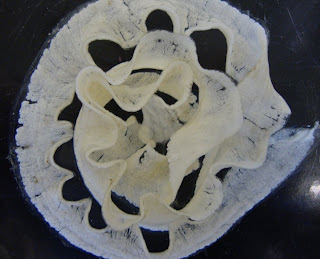


I was intrigued by the diversity of egg masses among marine gastropods (snails and slugs). In our Embryology class I observed three species with different habits of laying their eggs, namely, the snails
Nucella emarginata, and
Nassarius fossatus, and a nudibranch (or sea slug) called
Diaulula sandiegensis.
N. emarginata (also known as the “dog winkle”) and
N. fossatus (also known as the “giant western dog whelk”) belong to the group of marine prosobranchs and produce egg capsules which are leathery or hard, and tend to be attached to various substrata in the environment. The top picture shows two egg capsules laid in our sea table by
Nucella emarginata. These capsules are shaped like a wine goblet, and are opaque and hard, and each contains numerous eggs. The middle picture shows a single egg capsule of
Nassarius. These are more or less transparent, so the eggs are easily visible through the wall of the capsule. When well fed, these scavenger snails will lay egg capsules attached to the walls of sea table, or the hose as close to the surface of the water as they can get. These egg capsules are beautifully sculptured. The bottom picture is of the egg mass laid in our sea table by the nudibranch
Diaulula sandiegensis. Opisthobranchs, in general, lay their eggs in gelatinous ribbon-like masses. These masses are often loosely attached to the substratum, and tend to be only a few eggs thick.


 I was intrigued by the diversity of egg masses among marine gastropods (snails and slugs). In our Embryology class I observed three species with different habits of laying their eggs, namely, the snails Nucella emarginata, and Nassarius fossatus, and a nudibranch (or sea slug) called Diaulula sandiegensis. N. emarginata (also known as the “dog winkle”) and N. fossatus (also known as the “giant western dog whelk”) belong to the group of marine prosobranchs and produce egg capsules which are leathery or hard, and tend to be attached to various substrata in the environment. The top picture shows two egg capsules laid in our sea table by Nucella emarginata. These capsules are shaped like a wine goblet, and are opaque and hard, and each contains numerous eggs. The middle picture shows a single egg capsule of Nassarius. These are more or less transparent, so the eggs are easily visible through the wall of the capsule. When well fed, these scavenger snails will lay egg capsules attached to the walls of sea table, or the hose as close to the surface of the water as they can get. These egg capsules are beautifully sculptured. The bottom picture is of the egg mass laid in our sea table by the nudibranch Diaulula sandiegensis. Opisthobranchs, in general, lay their eggs in gelatinous ribbon-like masses. These masses are often loosely attached to the substratum, and tend to be only a few eggs thick.
I was intrigued by the diversity of egg masses among marine gastropods (snails and slugs). In our Embryology class I observed three species with different habits of laying their eggs, namely, the snails Nucella emarginata, and Nassarius fossatus, and a nudibranch (or sea slug) called Diaulula sandiegensis. N. emarginata (also known as the “dog winkle”) and N. fossatus (also known as the “giant western dog whelk”) belong to the group of marine prosobranchs and produce egg capsules which are leathery or hard, and tend to be attached to various substrata in the environment. The top picture shows two egg capsules laid in our sea table by Nucella emarginata. These capsules are shaped like a wine goblet, and are opaque and hard, and each contains numerous eggs. The middle picture shows a single egg capsule of Nassarius. These are more or less transparent, so the eggs are easily visible through the wall of the capsule. When well fed, these scavenger snails will lay egg capsules attached to the walls of sea table, or the hose as close to the surface of the water as they can get. These egg capsules are beautifully sculptured. The bottom picture is of the egg mass laid in our sea table by the nudibranch Diaulula sandiegensis. Opisthobranchs, in general, lay their eggs in gelatinous ribbon-like masses. These masses are often loosely attached to the substratum, and tend to be only a few eggs thick.



No comments:
Post a Comment